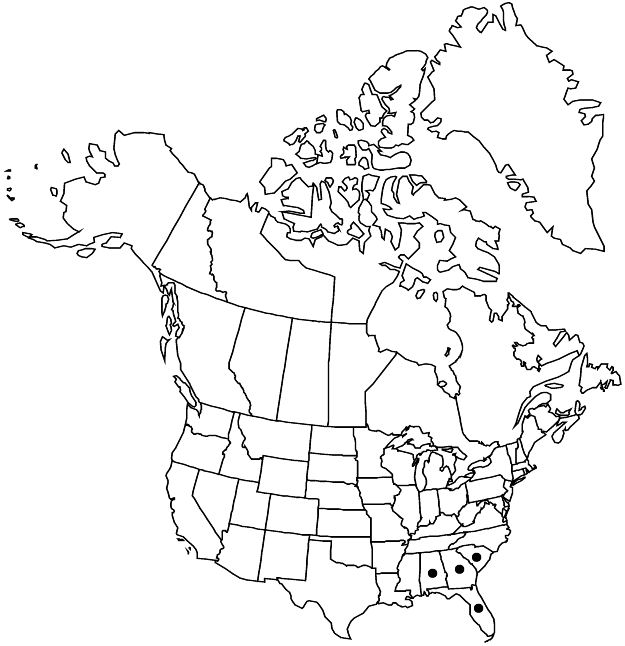Difference between revisions of "Piriqueta cistoides"
Fl. Brit. W. I., 298. 1860.
FNA>Volume Importer |
imported>Volume Importer |
||
| Line 29: | Line 29: | ||
-->{{Treatment/Body | -->{{Treatment/Body | ||
| − | |distribution= | + | |distribution=Ala.;Fla.;Ga.;S.C.;West Indies;South America. |
|discussion=<p>Subspecies 2 (1 in the flora).</p><!-- | |discussion=<p>Subspecies 2 (1 in the flora).</p><!-- | ||
--><p>Within <i>Piriqueta</i>, <i>P. cistoides</i> has the widest distribution. Both subspecies show wide morphological variation; subsp. cistoides is homostylous and self compatible; <i></i>subsp.<i> caroliniana</i> is distylous and self incompatible. In Cuba, Dominican Republic, and northern South America, intermediate specimens (10% of the total) cannot be assigned morphologically to one subspecies or the other. R. Ornduff (1970c) made crosses between and among the subspecies; he found no reproductive barriers among the different morphs of <i></i>subsp.<i> caroliniana</i>; the fertility of the hybrids between both subspecies was higher than that of the hybrids among populations of subsp. cistoides. Subspecies cistoides has been reported from Georgia; the author has not seen specimens.</p> | --><p>Within <i>Piriqueta</i>, <i>P. cistoides</i> has the widest distribution. Both subspecies show wide morphological variation; subsp. cistoides is homostylous and self compatible; <i></i>subsp.<i> caroliniana</i> is distylous and self incompatible. In Cuba, Dominican Republic, and northern South America, intermediate specimens (10% of the total) cannot be assigned morphologically to one subspecies or the other. R. Ornduff (1970c) made crosses between and among the subspecies; he found no reproductive barriers among the different morphs of <i></i>subsp.<i> caroliniana</i>; the fertility of the hybrids between both subspecies was higher than that of the hybrids among populations of subsp. cistoides. Subspecies cistoides has been reported from Georgia; the author has not seen specimens.</p> | ||
| Line 46: | Line 46: | ||
|basionyms=Turnera cistoides | |basionyms=Turnera cistoides | ||
|family=Turneraceae | |family=Turneraceae | ||
| − | |distribution= | + | |distribution=Ala.;Fla.;Ga.;S.C.;West Indies;South America. |
|reference=None | |reference=None | ||
|publication title=Fl. Brit. W. I., | |publication title=Fl. Brit. W. I., | ||
|publication year=1860 | |publication year=1860 | ||
|special status=Illustrated | |special status=Illustrated | ||
| − | |source xml=https:// | + | |source xml=https://bibilujan@bitbucket.org/aafc-mbb/fna-data-curation.git/src/bb6b7e3a7de7d3b7888a1ad48c7fd8f5c722d8d6/coarse_grained_fna_xml/V6/V6_302.xml |
|genus=Piriqueta | |genus=Piriqueta | ||
|species=Piriqueta cistoides | |species=Piriqueta cistoides | ||
Revision as of 23:39, 27 May 2020
Distribution

Ala., Fla., Ga., S.C., West Indies, South America.
Discussion
Subspecies 2 (1 in the flora).
Within Piriqueta, P. cistoides has the widest distribution. Both subspecies show wide morphological variation; subsp. cistoides is homostylous and self compatible; subsp. caroliniana is distylous and self incompatible. In Cuba, Dominican Republic, and northern South America, intermediate specimens (10% of the total) cannot be assigned morphologically to one subspecies or the other. R. Ornduff (1970c) made crosses between and among the subspecies; he found no reproductive barriers among the different morphs of subsp. caroliniana; the fertility of the hybrids between both subspecies was higher than that of the hybrids among populations of subsp. cistoides. Subspecies cistoides has been reported from Georgia; the author has not seen specimens.
Selected References
None.